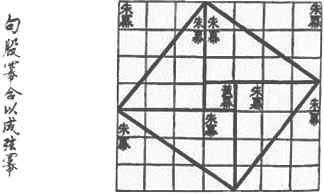《一》 幾何學題篇引言
《二》 幾何學的基本邏輯概念爻
《三》 天符經
《四》 自然數是三個三角形數之和
《五》 什麼是四象 五行八卦九疇
《六》 中國算盤和九九邏輯圖
《七》 通天连列图
《八》 四易原位結構圖
《九》 九图中國文化的經典的結構1
《十》 中國文化的經典的結構2
《十一》 中國文化的經典的結構3
《十二》 中國文化的經典的結構4
《十三》 中國文化的經典的結構5
Proof #3
 Now we start with four copies of the same triangle. Three of these have been rotated 90o, 180o, and 270o, respectively. Each has area ab/2. Let's put them together without additional rotations so that they form a square with side c. The square has a square hole with the side (a - b). Summing up its area (a - b)2 and 2ab, the area of the four triangles (4•ab/2), we get c2 = (a - b)2 + 2ab = a2 - 2ab + b2 + 2ab = a2 + b2 Proof #4 The fourth approach starts with the same four triangles, except that, this time, they combine to form a square with the side (a + b) and a hole with the side c. We can compute the area of the big square in two ways. Thus (a + b)2 = 4•ab/2 + c2 simplifying which we get the needed identity. A proof wich combines this with proof #3 is credited to the 12th century Hindu mathematician Bhaskara (Bhaskara II):    Here we add the two identities c2 = (a - b)2 + 4•ab/2 and c2 = (a + b)2 - 4•ab/2 which gives 2c2 = 2a2 + 2b2. The latter needs only be divided by 2. This is the algebraic proof # 36 in Loomis' collection. Its variant, specifically applied to the 3-4-5 triangle, has featured in the Chinese classic Chou Pei Suan Ching 《周髀算经》 dated somewhere between 300 BC and 200 AD and which Loomis refers to as proof 253. Proof #5 This proof, discovered by President J.A. Garfield in 1876 [Pappas], is a variation on the previous one. But this time we draw no squares at all. The key now is the formula for the area of a trapezoid - half sum of the bases times the altitude - (a + b)/2•(a + b). Looking at the picture another way, this also can be computed as the sum of areas of the three triangles - ab/2 + ab/2 + c•c/2. As before, simplifications yield a2 + b2 = c2.  Two copies of the same trapezoid can be combined in two ways by attaching them along the slanted side of the trapezoid. One leads to the proof #4, the other to proof #52. Proof #6 We start with the original triangle, now denoted ABC, and need only one additional construct - the altitude AD. The triangles ABC, BDA and ADC are similar which leads to two ratios: AB/BC = BD/AB and AC/BC = DC/AC.  Summing up we get
Summing up we getAB•AB + AC•AC = BD•BC + DC•BC = (BD+DC)•BC = BC•BC. In a little different form, this proof appeared in the Mathematics Magazine, 33 (March, 1950), p. 210, in the Mathematical Quickies section, see Mathematical Quickies, by C. W. Trigg. Taking AB = a, AC = b, BC = c and denoting BD = x, we obtain as above  a2 = cx and b2 = c(c - x), a2 = cx and b2 = c(c - x), which perhaps more transparently leads to the same identity. In a private correspondence, Dr. France Dacar, Ljubljana, Slovenia, has suggested that the diagram on the right may serve two purposes. First, it gives an additional graphical representation to the present proof #6. In addition, it highlights the relation of the latter to proof #1. It must be mentioned that this proof is just a variant of the next one - Euclid's second and less known proof of the Pythagorean proposition. Source: http://www.cut-the-knot.org/pythagoras/index.shtml |
